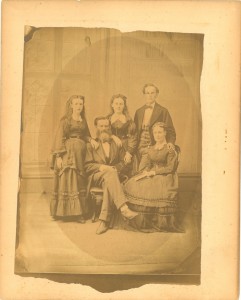Henry Woodcock also kept up a correspondence with his two daughters; Elizabeth, called Lizzie (b. 1855), and Ellen, called Nellie (b. 1857), the children of his second wife, Lucy Thayer Woodcock.1 Lizzie married Presley Whilite Budd, a farmer in Basehor, Kansas, and had one child, a son named Roy. She was a Methodist and held a number of church offices.2 Nellie married Charles Green Upton and had three children: Arthur (b. 1890), Walter (b. 1892), and Mina (b. 1894). As an adult, she received a degree from the University of Kansas. After he left Tonganoxie, Henry lived with Nellie Woodcock Upton and her family.3

While the letters Henry Woodcock wrote to his two daughters later in his life may at first seem inconsequential, their content demonstrates the same closeness that was exhibited in his correspondence with his sister, Lucy A. Woodcock. The content of the letters includes such everyday matters as the doings of family members, the weather and harvest, and the hiring of domestic servants, but they also deal with far more serious subjects. In his letter to Nellie dated 9 June 1883, Henry discusses his feelings about the death of his first wife, and then moves into spiritual reflections, noting with a touch of poignancy and mortality that “now is my salvation nearer than when I first entered the ministry.”4 The candid way he discusses both his grief and his own mortality with Nellie indicates the level of closeness between them, all the more evident since the woman he grieved for was not Nellie’s mother. In addition to matters of emotions, Henry also clearly felt comfortable discussing various aspects of his work with his daughters, including his own frustrations. Like Lucy’s willingness to confide her complaints, Henry’s casual descriptions of his annoyance with the inadequacies of his co-workers in these letters indicate that he both respects his daughter’s intelligence and trusts her to be discreet. He also discusses with his daughters his continued work in the cause of civil rights, the continuation of abolition. In his 31 March 1899 letter to Lizzie, he encloses a newspaper column he wrote about the Amistad Captives on the anniversary of their mutiny, illustrating that he desired to share his understanding of the history of the anti-slavery cause. Likely he hoped his daughters would continue in advocating for the cause of civil rights, as he and his sister had.5

Title: Selection of Henry Woodcock’s Railway Fare Cards, Source: Oberlin College Archives, The Henry Edwin Woodcock Papers. Series 4. Miscellany, 1987/67. 1989/141. RG 30/81.
Also of interest in these letters are the ways in which they indicate shifts in traditional gender roles. Though the maintenance of the home and family was traditionally the province of the woman of the house, Henry appears to take on many of these duties himself. He corresponded not only with his daughters, but with many members of his family, and seems to have taken on the maintenance of kinship networks that normally fell to women. As he discusses in these letters, he also took responsibility for the hiring and and keeping of domestic staff, another job which was traditionally given to women. Although his descriptions of these domestic women seem more bound in traditional gender roles than do his relationships with his daughters or sister (and suggest the ways in which class played a significant role in the way women were viewed), Henry’s involvement in the domestic side of his house highlights the fact that the late nineteenth century was a time when gender roles were changing and becoming less rigid.
1Oberlin College Archives, The Henry Edwin Woodcock Papers. Series 2. Writings. 1987/67. 1989/141. RG 30/81.
2Oberlin College Archives, The Henry Edwin Woodcock Papers. Series 4. Files Relating to the Woodcock Family.
3Oberlin College Archives, The Henry Edwin Woodcock Papers. Series 4. Files Relating to the Woodcock Family.
4Oberlin College Archives, The Henry Edwin Woodcock Papers. Series 1. Correspondence.
5A copy of the column he wrote is included alongside his 31 March 1899 letter in this collection.